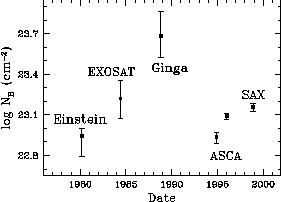


2.2. X-ray Absorption as a Probe of the Parsec Scale Torus
The large fraction of Compton thick sources constrains the size of the
obscuring medium. Indeed, assuming an axisymmetric geometry, the mass of the
gas responsible for the obscuration is about Mgas
 f NH R2,
where R is the external radius of the torus and f is the covering factor
which, for the Compton thick medium, must be of the order of 0.5. As
discussed in
Risaliti et al. (1999),
the requirement that the gas mass does not
exceed the dynamical mass constrains the external radius of the torus to
R < 10 pc. Enhanced metallicity could help to relax this constraint.
Metallicities a few times solar have actually been inferred for the BLR and
in the warm absorber of several Sy1s, but an order of magnitude higher
metallicities would be required to relax the mass constraints enough to
match the size of the torus of a few
100 pc proposed by some models (sect. 2.3).
f NH R2,
where R is the external radius of the torus and f is the covering factor
which, for the Compton thick medium, must be of the order of 0.5. As
discussed in
Risaliti et al. (1999),
the requirement that the gas mass does not
exceed the dynamical mass constrains the external radius of the torus to
R < 10 pc. Enhanced metallicity could help to relax this constraint.
Metallicities a few times solar have actually been inferred for the BLR and
in the warm absorber of several Sy1s, but an order of magnitude higher
metallicities would be required to relax the mass constraints enough to
match the size of the torus of a few
100 pc proposed by some models (sect. 2.3).
A parsec-scale size of the obscuring torus is also supported by the variability of NH. Indeed, in several Seyfert galaxies the photoelectric cutoff is observed to change significantly on time scales of a few years (Malizia et al. 1997). Fig. 2 shows the specific case of NGC7582 (from a compilation of results in Turner et al. 2000, Xue et al. 1999 and references therein, where the same model was adopted to fit the data). Although in some cases differences in NH measured at different epochs might be ascribed to the different satellite used, in some cases variation of NH are observed even with the same satellite. Finally, I recall that a parsec-scale component of the obscuring torus has been directly observed in radio VLBI images, both in continuum (free-free) and H2O maser emission, in a few active nuclei (eg. Gallimore et al. 1997, Greenhill & Gwinn 1997).

|
Figure 2. Variation of the absorbing NH in the Seyfert 2 galaxy NGC7582. |